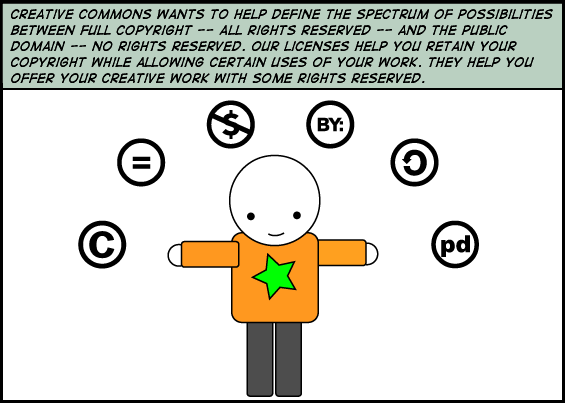Creative Commons
"Creative Commons is the air that the OER (Open Educational Resources) movement breathes. It is the legal enabler that eases the complexities of intellectual property in education, helping us move from a restrictive culture to a free culture." Wayne Mackintosh, founder Wikieducator (Vollmer, 2010)
What is Creative Commons?
Creative Commons (CC) operates under the principle idea that everyone should be able to share, use, remix, and reproduce various types of sources for educational and non-educational purposes with no cost to them. There are many types of licenses that can come with a creative commons product or resource. Users can access materials through the all rights reserved license, some rights reserved license or even the no rights reserved license. Using creative commons and loading resources to it does not mean that a person relinquishes their licensing rights. In fact, creative commons works globally under the copyright laws to ensure that the licensing rights meet the needs of those providing the resources and those using them.
The goal is “to increase the amount of creativity (cultural, educational, and scientific content) in ‘the commons’” so that “everyone from individual creators to large companies and institutions” can “grant copyright permissions to their creative work” (Creativecommons.org).
History of Creative Commons
Creative Commons was founded by the Center for the Public Domain in 2001. One of the co-founders is Lawrence Lessig, well known free culture advocate. Creative Commons currently operates under a board of directors that includes MIT computer science directors, cyberlaw and property law directors, educators, journalists and even documentary filmmakers. CC released its first set of copyright licenses in 2002 that were free and open to the public. The licenses were released with the help of the Free Software Foundation’s GNU General Public License (GNU GPL) and the Web Application platform in order to help users share their work and to chose how public and free they wanted it to be.
How far CC has come:

|
|
|
|
|
|
|
|
|
|
|
|
|
|
|
|
|
|
Types of Creative Commons Licenses
Attribution:
Users can copy, distribute, display, and create derivative works as long as the original creator is credited
Share Alike:
Users can copy, distribute, display, and create derivative works, but must license new work as Share Alike
No Derivatives:
Users can copy, distribute, display but not create derivative work
Non-Commercial:
The work can not be used commercially
Non-Commercial Share Alike:
Users can copy, distribute, display, and create derivative works but only in non commercial application; any new versions must use same license
Non-Commercial No Derivatives:
Users can copy, distribute, display, but only in non commercial application; no derivative work allowed.
How is Creative Commons Valuable for Education?
What is legal? If one wants to use a picture, music, or an interesting video in their digital presentation can they? The internet and web 2.0 are changing education and learning. Students hunger for new and innovative ways to express their thoughts and it is up to educators to work to feed that desire. Creative Commons licenses offer a way for educators to do just that without the fear of dealing with lawsuits or copyright issues.
Teachers and students can now share their creative work with the world and access the materials and works of others. They can be a part of the creation and evolution of this changing digital world. However, the legal and technical restrictions that exist today stand as an obstacle for educators to truly take part in enhancing this digitally driven world.
“Creative Commons provides the tools necessary to overcome these restrictions, opening up educational resources so that they are not only accessible, but adaptable, interoperable, and discoverable — helping to realize the full benefits of digitally enabled education” (Creativecommons.org).
CC licenses enable collaboration in the digital world. They provide educators with a way to digitally enhance their lesson plans and units in order to meet the needs of 21st century students while avoiding legal and technical issues at the same time.
For example, CC has launched a new platform for educators and learners to do just that.
"Curriki is known as the “next generation wiki” for K-12 education; it is an online community and wiki platform for teachers, learners, and education experts to share, reuse, and remix quality curricula. Teachers can find and develop resources, share lesson plans, and collaborate on courses with others in their school or around the world. All content is available under CC BY” (Creativecommons.org).
Next up Lessig on the Network we Need
